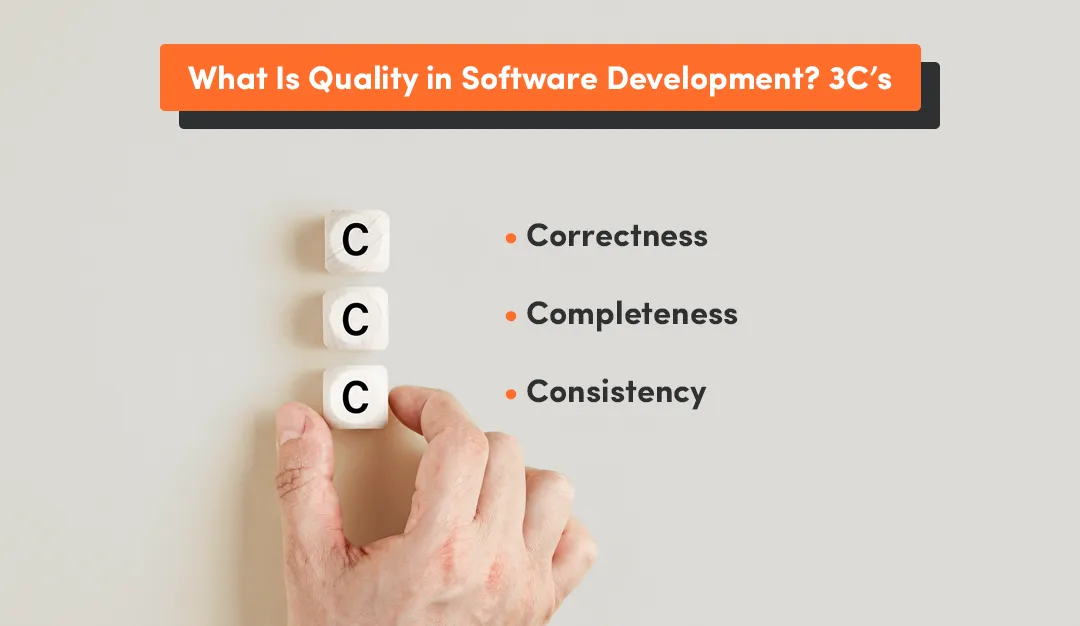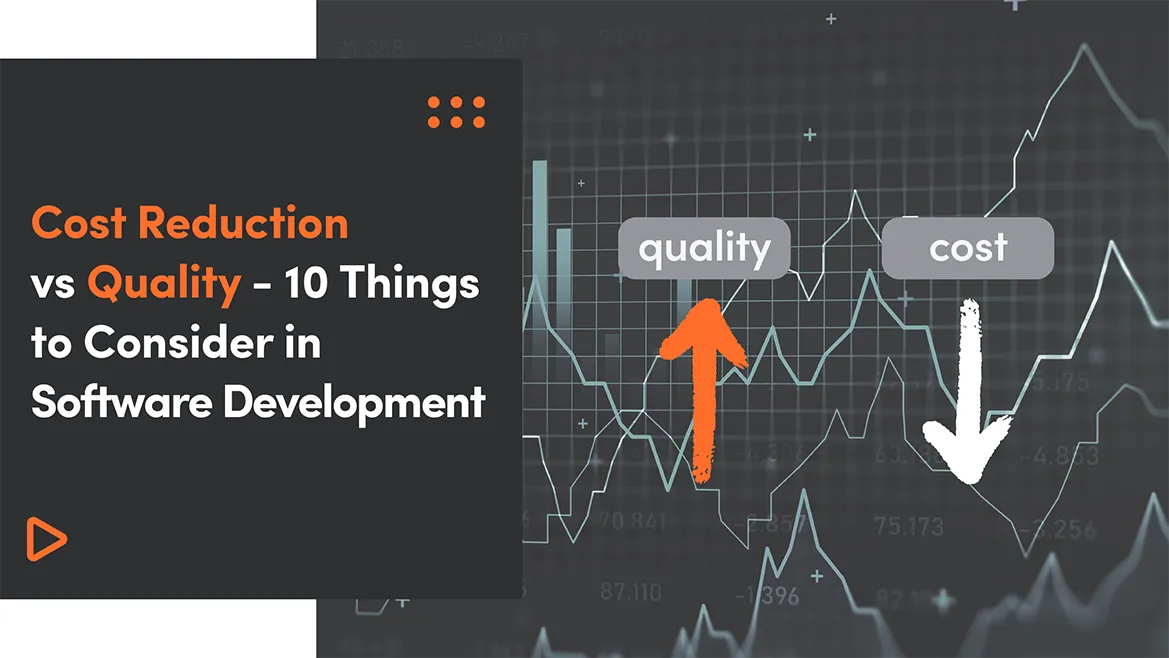The need to create software that is efficient, reliable, and cost-effective is a challenge faced by organizations worldwide. In software development, managing expenses efficiently is vital for maintaining profitability. Businesses aim to minimize overall software development costs to remain competitive and allocate resources to other critical areas.
On the other hand, ensuring the quality of software products is paramount to meeting customer expectations and maintaining a competitive edge in the market.
But can you cut costs without compromising quality, or will the relentless pursuit of cost savings negatively impact the software's performance and reputation? The truth lies in achieving a delicate balance between these two essential aspects of software development.
In this article, we will explore the complex interplay between cost reduction and quality in software development, revealing how they impact each other. Furthermore, we will provide valuable insights and practical tips, discussing ten critical factors that every software development project should consider when navigating this delicate balance.
What you will learn from this article:
- Will the quality drop if I reduce costs?
- What are the 3 C's of quality software development?
- The key quality metrics for software development you must know
- The important practices to ensure software quality
- What are the factors that impact the cost of software development?
- An effective way a business owner may reduce custom software development costs
- The 10 best things to consider when comparing cost reduction vs quality in software development
What Is Quality in Software Development? 3C’s
Quality in software development is a multifaceted concept, encompassing various attributes that collectively ensure a software product meets or exceeds user expectations and industry standards.

The 3C's of quality software development is a useful framework to understand and assess quality:
- Correctness
This implies that the software performs its intended functions accurately and reliably. It is free from critical bugs, errors, and logical flaws. Users can trust that the software will consistently produce the expected results and handle different scenarios without breaking or malfunctioning.
- Completeness
This second characteristic pertains to the extent to which the software fulfills its specified requirements and objectives. A high-quality software product must meet all the defined criteria, ensuring that no crucial features or functions are missing. Completeness ensures that the software provides a comprehensive solution to the problem it was designed to address.
- Consistency
Consistency involves the uniformity and coherence of the software throughout its design and user experience. A quality software product maintains a consistent interface, behavior, and performance across different platforms and environments. It adheres to design standards and follows a logical and predictable pattern in its user interactions.
10 Software Quality Metrics You Must Know
Measuring software quality is essential for ensuring that the software development process is effective and efficient, and results in high-quality products. The following are ten important software quality metrics that every software development company should consider.
Total Code Churn
Total code churn quantifies the number of lines of code that have been added, modified, or deleted within a codebase during a specific time period, such as a development sprint or release cycle.
High code churn can lead to increased complexity and can make it challenging to maintain code quality, which, in turn, may result in reduced software stability and longer development cycles.
Therefore, it's important to strike a balance between making necessary improvements and minimizing unnecessary code changes to maintain software quality.
Crash Rate
This quality metric measures how frequently a software product experiences crashes. Crashes are instances where the software unexpectedly and abruptly stops working, rendering it inoperable for end users. These crashes often result from unforeseen errors, including defects that may not have been identified during testing, sudden system overloads, or other unexpected issues.
When crashes occur, they disrupt the software's normal operation and can sometimes lead to data loss, causing inconvenience and potential data-related problems for users. A high crash rate is a red flag for any software application.
System Availability
This measures the amount of time a system is operational and accessible to users, typically by comparing the system's uptime (the time it's available) to its downtime (the time it's not available) over a specific time period.
High system availability implies that the system experiences more uptime than downtime, which means users rarely lose access to the system.
This metric directly affects user satisfaction, as downtime can lead to frustration and loss of trust in the product.
Defect Density
This metric evaluates the number of defects, or issues, found in a software product in relation to its size. It's a relative measure that provides insight into the quality of the codebase.
Defects, in this context, are errors or issues that are identified by testers before the software product is released.
A high-quality codebase generally has a lower defect density, indicating that it requires fewer corrections and is easier to maintain, scale, and evolve.
Mean Time to Detect (MTTD)
This metric measures the average time it takes for a software development or support team to identify errors or defects in a software product.
A low MTTD indicates that the team is generally quick at discovering errors in the software.
In essence, a low MTTD is a positive sign of an efficient and responsive development and support process, ultimately contributing to improved software reliability and user satisfaction.
Mean Time Between Failures (MTBF)
This metric calculates the average time between two system failures. These failures can range from critical errors, such as crashes, to less severe issues where the software does not meet end users' expectations.
MTBF is essential for assessing the overall reliability and robustness of software products, especially after their release into production.
It helps in understanding how frequently users may experience issues, and a higher MTBF indicates that the software is more robust and less likely to fail.
Mean Time to Resolve (MTTR)
This metric quantifies the average time it takes for a software development or support team to address and fix an error or issue in a software product after it has been identified.
Typically, MTTR is calculated in terms of hours or minutes, considering only the time that falls within normal work hours (i.e., excluding nights or weekends).
A low MTTR indicates that the team is efficient at resolving errors swiftly.
In essence, a low MTTR signifies that the team is capable of responding promptly to issues, reducing the overall impact of errors, and ensuring a quicker return to normal operations.
Customer Satisfaction (CSAT)
While not a technical metric, CSAT is vital for software success. It measures how customers perceive and experience a software product. CSAT is typically determined by collecting and analyzing data from customer satisfaction surveys.
A higher CSAT score indicates a more positive perception, which means that customers are more satisfied with the product, leading to higher user retention and positive word-of-mouth.
Mean Time to Remediate a Vulnerability
This metric measures the average time it takes for your team to address and fix security vulnerabilities in the software.
A shorter Mean Time to Remediate (MTTR) for vulnerabilities indicates that your team is efficient at identifying and resolving security issues promptly.
This is crucial for maintaining the security of the software and protecting it from potential threats or breaches.
Code Coverage
Code coverage is a metric related to testing. It measures the extent to which the codebase is tested. For high code coverage, programmers must create unit tests that cover every line of code, including various conditions and use cases in the product's functionality. When a software product achieves high code coverage and all unit tests pass successfully, it is an indication of high code quality.
This high code quality, in turn, translates to high-quality software, as it implies that the codebase is thoroughly tested and less prone to defects and issues, ultimately leading to a more reliable and stable software product.
Try our developers.
Free for 2 weeks.
No risk. Just results. Get a feel for our process, speed, and quality — work with our developers for a trial sprint and see why global companies choose Selleo.
What Are the Most Important Practices to Ensure Software Quality?

Ensuring software quality is of paramount importance for software houses providing outsourcing services. Clients trust these firms to deliver high-quality software that meets their requirements, and failure to do so can lead to dissatisfaction and damage the reputation of the outsourcing provider. To meet these expectations, software houses employ several key practices to ensure software quality:
Establishing Clear Requirements
One of the fundamental building blocks for delivering high-quality software in an outsourcing context is establishing clear and unambiguous requirements. A lack of clarity in project requirements can lead to misunderstandings, scope creep, and ultimately, subpar software. To ensure the delivery of high-quality software, software houses emphasize the following practices:
Detailed documentation of project specifications and clear and continuous communication with the client. They also employ validation and verification techniques to confirm that the requirements align with the client's objectives.
Using Agile Development Methodology
Agile is a project management and product development approach that prioritizes flexibility, collaboration, and customer satisfaction. Agile methods promote iterative development, where small portions of the software project are continuously refined.
For software houses, using agile development methods means that they can adapt to changing requirements quickly, delivering value to clients and end-users sooner. The iterative approach of agile development ensures that software quality is continually assessed and improved throughout the development process. By doing so, software quality is enhanced, and the end product aligns better with user needs.
Creating a Quality Culture
Building a culture of quality is fundamental in software development. It involves instilling the importance of quality in every team member. This includes setting quality standards, defining best practices, conducting regular code reviews, and promoting a sense of ownership for the product's quality. Fostering a culture of quality is a fundamental practice for outsourcing service providers. This approach instills a sense of responsibility and commitment to high standards among developers, testers, and other stakeholders involved in the software development process. Find out too Why Is a Quality Assurance Tester Needed On a Software Development Team?
Risk Management
Risk management is a crucial aspect of maintaining software quality. This involves identifying potential risks, such as scope creep, technical challenges, or resource limitations, and developing strategies to address them. By proactively addressing risks, software houses can minimize the chances of quality-related issues. This is especially crucial in outsourcing services, where the software development team may not have in-depth knowledge of the client's business domain.
Putting the User First
A fundamental aspect of software quality is ensuring that the end-user's needs and expectations are met. Outsourcing services often deal with clients from various industries, each with its unique requirements. To ensure software quality, it's imperative to understand the end-users' perspective and develop solutions that are user-friendly and efficient.
Performing Diverse Test Early and Often
Testing is a critical aspect of software quality assurance. In outsourcing services, it's essential to perform diverse testing types, including functional, non-functional, and usability testing. Testing should start early in the development cycle and continue throughout the project to identify and address issues promptly. Automated testing, continuous integration, and continuous delivery (CI/CD) pipelines can help streamline the testing process, ensuring that software is thoroughly checked for quality at every stage.
What Factors Impact the Cost of Software Development
The cost of software development can vary significantly based on various factors. Understanding these factors is essential for businesses and individuals looking to carry out a software development project. The following are some key elements that impact the cost of software development:

Who You Hire for the Job
The choice of who you hire for your software development project plays a pivotal role in cost determination.
Hiring in-house developers means employing a team of full-time professionals dedicated to your project. While this offers more control and real-time communication, it can be expensive due to salaries, benefits, and infrastructure costs.
On the other hand, outsourcing your software development to third-party vendors or freelance developers can be cost-effective. You pay for the work done without bearing the overhead costs of hiring full-time staff. However, it's essential to find reliable outsourcing partners.
Where You Hire
The location of your development team can significantly affect software project costs. Hiring onshore developers, located within your country, can be costly due to higher living standards and wages. Hiring developers from a different country can be cost-effective due to lower labor costs. However, it may present communication challenges.
Complexity of Software

The complexity of the software you intend to develop is also a crucial factor in cost determination. Basic applications with standard features and functionalities are the least expensive to develop, typically requiring approximately 500 to 700 development hours. The associated cost for developing such applications falls within the range of $20,000 to $80,000.
Medium-complexity applications, characterized by a higher level of intricacy in their features, typically require an estimated 700 to 1200 development hours. The associated cost for developing such applications falls within the range of $80,000 to $150,000.
Highly intricate applications, such as enterprise software, require extensive development, testing, and ongoing support, leading to the highest development costs. The cost to develop a complex app can vary significantly and may fall within the range of $100,000 to $250,000 or even more. Due to the intricacies involved, the development of such applications typically exceeds 1200 hours.
How To Reduce Custom Software Development Costs?
To reduce custom software development costs, business owners can consider several strategies. First, they should clearly define project requirements and objectives to avoid scope creep and unnecessary revisions. Second, they can leverage open-source technologies and existing frameworks to minimize development from scratch. Additionally, outsourcing development to regions with lower labor costs or using in-house talent effectively can be cost-efficient. Lastly, employing agile methodologies and continuous testing ensures efficient use of resources and minimizes rework.
In summary, careful planning, resource optimization, and a strategic approach to development can help business owners reduce custom software development pricing without compromising quality or functionality.
Cost Reduction vs Quality - 10 Things to Consider
It's indeed possible to reduce software costs while maintaining quality in software development. The key lies in a strategic approach and careful consideration of various factors. Let's delve into the specifics:
Outsourcing/Offshoring
It is possible to reduce software development costs through outsourcing/offshoring, but careful selection of vendors is crucial. Quality can be maintained by establishing clear communication channels, setting expectations, and ensuring the offshore team aligns with your project goals and standards.
Measuring the Actual Costs of Saving
While reducing costs is feasible, it's essential to measure the actual costs of saving. This involves considering not only the initial development costs but also long-term factors like maintenance, support, and potential rework. This comprehensive analysis ensures that cost-cutting measures don't compromise overall quality.
Hidden Costs
Hidden costs, like training, integration, or unforeseen issues, can impact the project's total cost. Recognizing and accounting for these costs in the planning phase is crucial to avoid compromising quality in the pursuit of apparent cost savings.
Accuracy in Schedule Planning
Accurate schedule planning is essential for both cost reduction and maintaining quality. Rushed development to meet tight deadlines can lead to defects and reduced quality. Realistic schedules that allow for thorough testing contribute to a successful balance between cost and quality.
Deciding On the Technology Stack
Choosing an appropriate technology stack is a balancing act. Cutting-edge technologies may offer long-term benefits but might involve higher initial costs. Striking a balance by aligning the stack with both budget constraints and quality requirements ensures a cost-effective yet robust solution.
Balancing Between Skill and Experience
While skill is vital, experience brings a unique perspective and a deeper understanding of potential pitfalls. Striking a balance between hiring seasoned professionals and those with cutting-edge skills can create a synergistic team capable of delivering high-quality software within budget constraints.
Tracking Your Budget vs. Actual Expenditure
It is possible to maintain quality while reducing costs by implementing rigorous budget tracking. Regularly comparing budgeted versus actual expenditure allows for adjustments, preventing cost overruns and ensuring that adequate resources are allocated to quality assurance processes.
Testing and Quality Assurance
Testing and quality assurance are integral to maintaining high standards. Allocating sufficient resources and time for thorough testing ensures that the software meets quality benchmarks. Cutting corners in this phase may lead to post-release issues that could ultimately increase costs.
Boeing faced software-related challenges with the Starliner project, leading to two unsuccessful launch attempts. The reported losses linked to the project amount to a staggering $595 million since 2019, signaling a substantial financial setback.
An independent review board revealed that two crucial software defects were not identified prior to the flight, despite the presence of multiple safeguards, as stated in an official agency statement.
Douglas Loverro, the Director of Spaceflight Operations at NASA Headquarters, stated that the concerns raised by investigators extend beyond the specific software errors and an unforeseen communication glitch that initially impeded flight controllers from commanding the spacecraft.
This instance highlights how cost-cutting measures, if not carefully implemented, can lead to severe consequences, both financially and in terms of product/service quality.
Summary
In summary, achieving a balance between cost reduction and maintaining quality in software development demands a nuanced and strategic approach. The article explores crucial factors that shed light on the interplay between cost reduction and quality. While acknowledging that certain businesses with standardized projects may navigate this balance more successfully, it emphasizes the need for cautious navigation.
For businesses where scalability, standardized processes, and a well-defined scope are predominant, cost-reduction measures can often be implemented without compromising the integrity of the final product. However, in industries where customization, innovation, and intricate solutions are paramount, a relentless pursuit of cost reduction may inadvertently lead to a decline in software quality.
To successfully tread this fine line, businesses must carefully analyze their scope, objectives, and the nature of their software development projects.
In essence, the key takeaway is not a one-size-fits-all approach but a tailored strategy based on a thorough understanding of your business model.
By critically evaluating the considerations outlined, coupled with other practical insights/tips in this article, businesses can make informed decisions that align with their unique needs.





